
A cactus is a member of the plant family Cactaceae, a family comprising about 127 genera with some 1,750 known species of the order Caryophyllales. The word cactus derives, through Latin, from the Ancient Greek word κάκτος (káktos), a name originally used by Theophrastus for a spiny plant whose identity is now not certain. Cacti occur in a wide range of shapes and sizes. They are native to the Americas, ranging from Patagonia in the south to parts of western Canada in the north, with the exception of Rhipsalis baccifera, which is also found in Africa and Sri Lanka. Cacti are adapted to live in very dry environments, including the Atacama Desert, one of the driest places on Earth. Because of this, cacti show many adaptations to conserve water. For example, almost all cacti are succulents, meaning they have thickened, fleshy parts adapted to store water. Unlike many other succulents, the stem is the only part of most cacti where this vital process takes place. Most species of cacti have lost true leaves, retaining only spines, which are highly modified leaves. As well as defending against herbivores, spines help prevent water loss by reducing air flow close to the cactus and providing some shade. In the absence of true leaves, cacti's enlarged stems carry out photosynthesis.

Puya is a genus of the botanical family Bromeliaceae. It is the sole genus of the subfamily Puyoideae, and is composed of 226 species. These terrestrial plants are native to the Andes Mountains of South America and southern Central America. Many of the species are monocarpic, with the parent plant dying after one flower and seed production event.
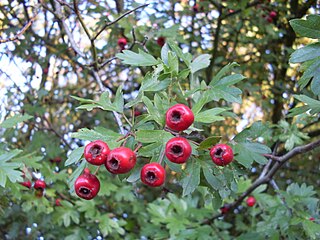
Crataegus monogyna, known as common hawthorn, one-seed hawthorn, or single-seeded hawthorn, is a species of flowering plant in the rose family Rosaceae. It is native to Europe, northwestern Africa, and Western Asia, but has been introduced in many other parts of the world.
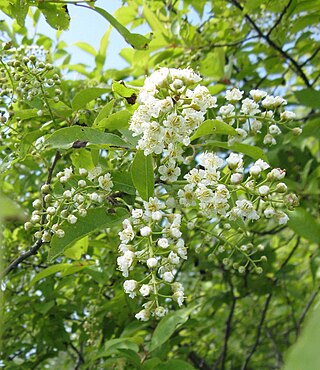
Prunus virginiana, commonly called bitter-berry, chokecherry, Virginia bird cherry, and western chokecherry, is a species of bird cherry native to North America.

A man-eating plant is a legendary carnivorous plant large enough to kill and consume a human or other large animal. Various such myths and fictional tales exist around the world.

Parkinsonia aculeata is a species of perennial flowering tree in the pea family, Fabaceae. Common names include palo verde, Mexican palo verde, Parkinsonia, Jerusalem thorn, jelly bean tree, palo de rayo, and retama.

Cylindropuntia imbricata, the cane cholla, is a cactus found in the Southwestern United States and northern Mexico, including some cooler regions in comparison to many other cacti. It occurs primarily in the arid regions of the Southwestern United States in the states of Kansas, Oklahoma, Texas, New Mexico, Arizona, Colorado, and Nevada. It is often conspicuous because of its shrubby or even tree-like size, its silhouette, and its long-lasting yellowish fruits.

Rumex acetosella, commonly known as red sorrel, sheep's sorrel, field sorrel and sour weed, is a species of flowering plant in the buckwheat family Polygonaceae. Native to Eurasia and the British Isles, the plant and its subspecies are common perennial weeds. It has green arrowhead-shaped leaves and red-tinted deeply ridged stems, and it sprouts from an aggressive and spreading rhizome. The flowers emerge from a tall, upright stem. Female flowers are maroon in color.

Phytolacca americana, also known as American pokeweed, pokeweed, poke sallet, pokeberry, dragonberries, pigeonberry weed, and inkberry, is a poisonous, herbaceous perennial plant in the pokeweed family Phytolaccaceae. This pokeweed grows 1 to 3 metres. It has simple leaves on green to red or purplish stems and a large white taproot. The flowers are green to white, followed by berries which ripen through red to purple to almost black which are a food source for songbirds such as gray catbird, northern mockingbird, northern cardinal, and brown thrasher, as well as other birds and some small non-avian animals.

Carpobrotus, commonly known as pigface, ice plant, sour fig, Hottentot fig, and clawberry is a genus of ground-creeping plants with succulent leaves and large daisy-like flowers. The name comes from the Ancient Greek karpos "fruit" and brotos "edible", referring to its edible fruits.

Sambucus nigra is a species complex of flowering plants in the family Adoxaceae native to most of Europe. Common names include elder, elderberry, black elder, European elder, European elderberry, and European black elderberry. It grows in a variety of conditions including both wet and dry fertile soils, primarily in sunny locations. The plant is widely grown as an ornamental shrub or small tree. Both the flowers and the berries have a long tradition of culinary use, primarily for cordial and wine.

Puya raimondii, also known as the Raimondi Cove or the Queen of the Andes (English), titanka and ilakuash (Quechua) or puya de Raimondi (Spanish), is the largest species of bromeliad, its inflorescences reaching up to 15 m (50 ft) in height. It is native to the high Andes of Bolivia and Peru. It was once hypothesized to be a protocarnivorous plant. Aside from its extremely slow growth cycle and its longevity, the plant is known for its peculiar self-combustion at the end of its life.

A protocarnivorous plant, according to some definitions, traps and kills insects or other animals but lacks the ability to either directly digest or absorb nutrients from its prey like a carnivorous plant. The morphological adaptations such as sticky trichomes or pitfall traps of protocarnivorous plants parallel the trap structures of confirmed carnivorous plants.
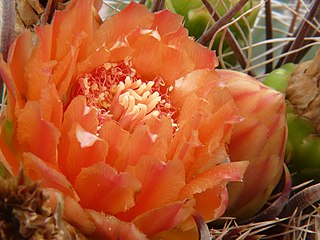
Ferocactus wislizeni, the fishhook barrel cactus, also called Arizona barrel cactus, candy barrel cactus, and Southwestern barrel cactus, is a species of flowering plant in the cactus family Cactaceae, native to northern Mexico and the southern United States. It is a ball-shaped cactus eventually growing to a cylindrical shape, with spiny ribs and red or yellow flowers in summer.
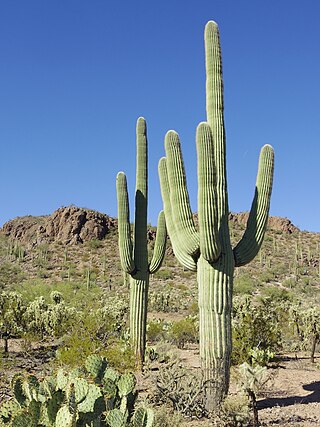
The saguaro is a tree-like cactus species in the monotypic genus Carnegiea that can grow to be over 12 meters tall. It is native to the Sonoran Desert in Arizona, the Mexican state of Sonora, and the Whipple Mountains and Imperial County areas of California. The saguaro blossom is the state wildflower of Arizona. Its scientific name is given in honor of Andrew Carnegie. In 1933, Saguaro National Park, near Tucson, Arizona, was designated to help protect this species and its habitat.

Crotalaria cunninghamii, also known as green birdflower, birdflower ratulpo, parrot pea or regal birdflower, is a plant of the legume family Fabaceae, named Crotalaria after the Greek word for rattle, because their seeds rattle, and cunninghamii after early 19th century botanist Allan Cunningham. Crotalaria cunninghamii is known as Mangarr to the Nyangumarta Warrarn Indigenous group.
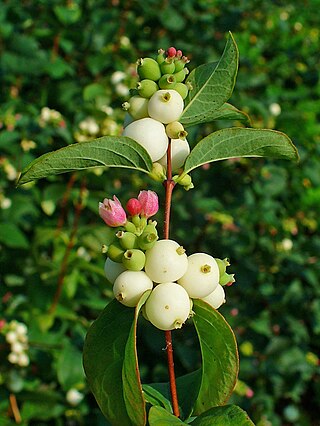
Symphoricarpos albus is a species of flowering plant in the honeysuckle family known by the common name common snowberry. Native to North America, it is browsed by some animals and planted for ornamental and ecological purposes, but is poisonous to humans.
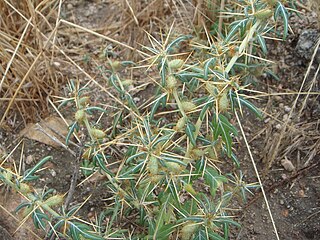
Xanthium spinosum is a species of flowering plant in the aster family known by many common names, including spiny cocklebur, prickly burweed and Bathurst burr. This species is part of the genus Xanthium that encompasses 25 different species of flowering plants of the daisy family, Asteraceae, and sunflower tribe.

Gaylussacia frondosa is a species of flowering plant in the heath family known by the common names dangleberry and blue huckleberry. It is native to the eastern United States, where it occurs from New Hampshire to South Carolina.
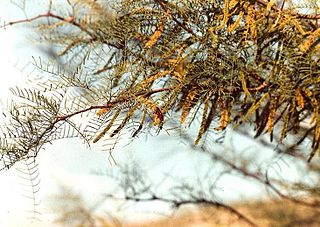
Prosopis chilensis is a species of tree in the genus Prosopis, belonging to the family Fabaceae. It is found in parts of central Chile, southern Peru, Bolivia, and Andean (northwestern) Argentina. Its common names include Chilean mesquite, cupesí, and Chilean algarrobo. It is used for providing shade, for animal feed and for firewood.






























